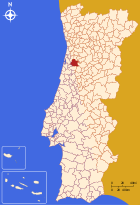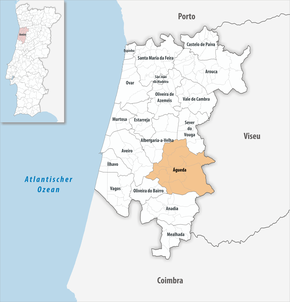Águeda
| Águeda | ||||||
|---|---|---|---|---|---|---|
|
||||||
| Basic data | ||||||
| Region : | Centro | |||||
| Sub-region : | Aveiro Region | |||||
| District : | Aveiro | |||||
| Concelho : | Águeda | |||||
| Coordinates : | 40 ° 35 ′ N , 8 ° 27 ′ W | |||||
| Residents: | 11,357 (as of June 30, 2011) | |||||
| Surface: | 27.33 km² (as of January 1, 2010) | |||||
| Population density : | 416 inhabitants per km² | |||||
| Postal code : | 3750-107 | |||||
| politics | ||||||
| Mayor : | Paulo Alexandre Guerra de Azevedo Seara | |||||
| Address of the municipal administration: | Junta de Freguesia de Águeda Largo Dr. António Homem de Mello, 74 3750-107 Águeda |
|||||
| Águeda district | ||||||
|
||||||
| Residents: | 47,729 (as of June 30, 2011) | |||||
| Surface: | 335.27 km² (as of January 1, 2010) | |||||
| Population density : | 142 inhabitants per km² | |||||
| Number of municipalities : | 11 | |||||
| administration | ||||||
| Administration address: | Câmara Municipal de Águeda Praça do Município 3754-500 Águeda |
|||||
| President of the Câmara Municipal: | Gil Nadais Resende da Fonseca ( PS ) | |||||
| Website: | www.cm-agueda.pt | |||||
Águeda is a city ( Cidade ) in Portugal with 11,357 inhabitants (as of June 30, 2011).
history
Today's Águeda district has a large number of finds from Roman times, especially at the archaeological excavation site Estação Arqueológica de Cabeço do Vouga . Presumably the Roman road from Aeminium (today Coimbra ) to Cale (today Gaia ) crossed the place. The place name is derived from the river running here, which was already known as Ágata in the 9th century . A document from 1050 mentions a number of vilas (small towns) in what is now Águeda County, many of which have names derived from Arabic .
The place was known as Casal Lausato before taking the name of the river as Agatha and then in the 11th century as Ágada . For its part, the river was originally named after Saint Agatha .
The current town of Águeda was probably built in the 11th or 12th century, during the repopulation during the Reconquista . A report by officials from Aveiro confirmed in 1451 , although a growing place that then but still did not receive their own civic rights, but in Aveiro city charter of 1515 by King D.Manuel I was wisely. Assequins, today a place of the municipality of Águeda, was given its own city rights by the king.
On December 31, 1853 , the independent district of Águeda was created. Industrial development followed, reinforced by the arrival of the railroad in 1908. On August 14, 1985 , the town, which had been a small town (Vila) since 1834, was elevated to a town (Cidade).
Culture and sights
Águeda has an interesting handicraft heritage in pottery, basketry, weaving, cooperage and lace making. The villages Urgueira , Macieira de Alcoba or Lourizela , which have retained an authentic rustic flair, are worth visiting . There are several folklore groups in the district.
Among the many churches, chapels and crossroads in the Águeda district, the Panteão dos Lemos in the Trofa do Vouga municipality deserves special attention.
Other places of interest to the visitor are the Pateira de Fermentelos (the largest natural lake on the Iberian Peninsula ) and the Roman excavations of Cabeço do Vouga .
In Macinhata do Vouga there is a branch of the Portuguese Railway Museum Museu Nacional Ferroviário, which opened in 1981 . Other museums include the Casa Museu do Cancioneiro de Águeda , a museum for local culture housed in a stately home from the 18th century, the Museu da Fundação Dionísio Pinheiro e Alice Cardoso Pinheiro , which opened in 1969, and the Museu Etnográfico da Região do Vouga , which opened in 1969 for regional ethnography , and the local museum Casa Museu João Tomás Nunes in Fermentelos .
gastronomy
The most famous specialty is the Barraida-style suckling pig ( Leitão assado à Bairrada ). The wines and sparkling wines of the Bairrada are also known. There are also some traditional desserts from Águeda: Pastéis de Águeda , Barriga de freira , Fuzis e Sequilhos , Regueifa , and the Padas da Veiga .
Sports
The football club Recreio Desportivo de Águeda , founded in 1924, played a season in the First Portuguese League after a few seasons in the Second Portuguese League in 1982/83 . After the following financial problems and relegations, he now plays at the district level. The club plays its home games in the Estádio Municipal de Águeda , which has a capacity of 10,000 .
Other associations in the district are the Associação Desportiva Valonguense (from Valongo do Vouga), the Sporting Clube de Fermentelos , founded in 1930 , and the União Desportiva Mourisquense, founded in 1949 from the town of Mourisca do Vouga, in the municipality of Trofa.
Águeda hosted the 2006 U-21 European Football Championship .
administration
The circle
 |
Águeda is the seat of a district of the same name ( concelho ) in the Aveiro district . On June 30, 2011 the district had 47,729 inhabitants on an area of 335.3 km². |
The neighboring districts of Águeda are (starting clockwise in the north): Sever do Vouga , Oliveira de Frades , Vouzela , Tondela , Mortágua , Anadia , Oliveira do Bairro , Aveiro and Albergaria-a-Velha .
With the regional reform in September 2013 , several municipalities were merged into new municipalities, so that the number of municipalities decreased from 20 to eleven.
The following eleven municipalities ( Freguesias ) are in the Águeda district:
| local community | Population (2011) |
Area km² |
Density of population / km² |
LAU code |
|---|---|---|---|---|
| Aguada de Cima | 4.013 | 28.39 | 141 | 010103 |
| Águeda e Borralha | 13,576 | 36.03 | 377 | 010121 |
| Barrô e Aguada de Baixo | 3,209 | 10.19 | 315 | 010122 |
| Belazaima do Chão, Castanheira do Vouga e Agadão | 1.611 | 88.09 | 18th | 010123 |
| Fermentless | 3,258 | 8.58 | 380 | 010109 |
| Macinhata do Vouga | 3,406 | 31.95 | 107 | 010112 |
| Préstimo e Macieira de Alcoba | 808 | 41.73 | 19th | 010127 |
| Recardães e Espinhel | 6,036 | 19.92 | 303 | 010124 |
| Travassô e Óis da Ribeira | 2,305 | 11.12 | 207 | 010125 |
| Trofa, Segadães e Lamas do Vouga | 4,630 | 16.07 | 288 | 010126 |
| Valongo do Vouga | 4,877 | 43.20 | 113 | 010119 |
| Águeda district | 47,729 | 335.27 | 142 | 0101 |
These include a town ( Cidade ), Águeda , and three small towns ( Vilas ): Aguada de Cima , Fermentelos , and Mourisca do Vouga in the municipality of Trofa, Segadães e Lamas do Vouga .
Population development
| Population in Águeda County (1849–2011) | ||||||||
|---|---|---|---|---|---|---|---|---|
| 1849 | 1900 | 1930 | 1960 | 1981 | 1991 | 2001 | 2011 | |
| 9,247 | 20,416 | 25,982 | 35,274 | 43,216 | 44,045 | 49,041 | 47,817 | |

Municipal holiday
- eighth Monday after Easter Sunday
Town twinning
-
 : Rio Grande , Brazil (since November 16, 1993)
: Rio Grande , Brazil (since November 16, 1993) -
 : Bissau , Guinea-Bissau (since March 10, 1995)
: Bissau , Guinea-Bissau (since March 10, 1995) -
 : Ferrol , Spain (since August 26, 1999)
: Ferrol , Spain (since August 26, 1999) -
 : Sint-Gillis-Waas , Belgium (since August 25, 2000)
: Sint-Gillis-Waas , Belgium (since August 25, 2000)
economy
The region around Águeda is very fertile; corn, fruit and wine are grown and wood is extracted. Some of the municipalities in the Águeda district are located in the wine-growing region of Bairrada , which, in addition to its internationally sold wines, is also known nationwide for its suckling pig.
In addition to agriculture, trade and industry are important. The metalworking industry in particular is based in Águeda. a. Engines, motorcycles and bicycles are produced.
traffic
The Linha do Vouga railway passes through the Águeda district at several stops.
Junction 15 ( Aveiro Sul ) of the A1 motorway is in the Fermentelos municipality . The national road N1 bypasses the district town of Águeda as expressway IC2. It connects the town to the A25 motorway, which runs about 15 km to the north, and leads 40 km south to Coimbra .
Águeda is integrated into the national bus network of Rede Expressos .
sons and daughters of the town
- Fernando Caldeira (1841-1894), writer
- Francisco Ferraz de Macedo (1845–1907), pharmacist, physician and anthropologist
- Manuel Homem de Melo da Câmara (1866–1953), politician and journalist, Count of Águeda
- Adolfo Rodrigues da Costa Portela (1866–1923), writer, poet and dramaturge
- João Domingues Arêde (1869–1953), clergyman and historian known as Abade Arede
- Arménio Gomes dos Santos (1900–1971), educator, journalist and writer
- Hernâni Ferreira da Silva (1931–2001), football player
- Fernando Braz da Costa (* 1932), local poet
- Manuel Alegre (* 1936), poet and politician, presidential candidate of the PS 2006 and 2011
- António de Vasconcelos Nogueira (* 1961), philosopher, social scientist, writer and university professor
- Carlos Ala (* 1962), rally driver, multiple participant in the Dakar Rally
- Eduardo Veiga (* 1962), rally driver
- Afonso de Melo (* 1964), journalist and author
- Nucha (* 1966), singer
- Fábio Cardoso (* 1994), football player
Manuel Alegre (portrait of Carlos Botelho )
Web links
Individual evidence
- ↑ www.ine.pt - indicator resident population by place of residence and sex; Decennial in the database of the Instituto Nacional de Estatística
- ↑ a b Overview of code assignments from Freguesias on epp.eurostat.ec.europa.eu
- ↑ a b www.ine.pt - indicator resident population by place of residence and sex; Decennial in the database of the Instituto Nacional de Estatística
- ^ João Fonseca: Dicionário do Nome das Terras. 2nd edition, Casa das Letras, Cruz Quebrada 2007, p. 14 ( ISBN 978-9724617305 )
- ↑ www.verportugal.net , accessed October 29, 2013
- ^ Page of the museum branch ( memento of November 21, 2013 in the Internet Archive ) on the city administration's website, accessed on November 1, 2013
- ↑ The stadium at www.igogo.pt, accessed on November 1, 2013
- ^ Publication of the administrative reorganization in the Diário da República gazette of January 28, 2013, accessed on March 16, 2014
- ↑ www.anmp.pt , accessed on November 1, 2013
| ← Previous location: Anadia |
|
Next town: Oliveira do Bairro → |











